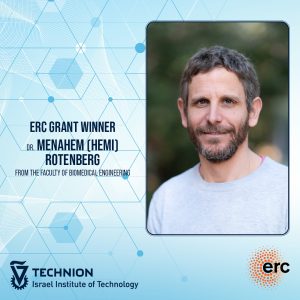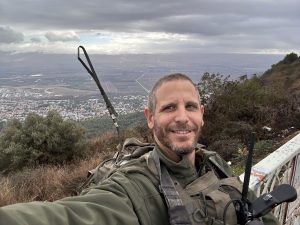New Technology for Nerve Tissue Regeneration
The Technion’s Dr. Hemi Rotenberg has been awarded the prestigious ERC Starting Grant, which will allow him to develop interfaces for nerve tissue regeneration
Dr. Hemi Rotenberg was named by the European Research Commission as one of the winners of its ERC Starting Grants, which assist promising young scientists in advancing their research, forming research teams, and pursuing bold and original ideas. Winning candidates for the awards, which were announced in September, must demonstrate the potential for scientific breakthroughs, strong ambition, and the feasibility of their research proposals.
Dr. Rotenberg completed all of his degrees at Ben-Gurion University of the Negev and conducted his postdoctoral research at the University of Chicago. Today, he heads the Laboratory for Bio-Electrical and Bio-Mechanical Interfaces at the Faculty of Biomedical Engineering.
Dr. Rotenberg is developing methods for precise stimulation of cells and tissues. In 2022, he published a new technology to restore damaged nerve tissues and heart pacing using an external light source to the body. The grant will be used to develop an electro-mechanical interface for brain tissue engineering. This interface will combine optoelectronic and magnetic components and will enable researchers to apply precise electrical and mechanical modulations to different parts of the cell. According to Dr. Rotenberg, this is a complex project, and he hopes to recruit new students and postdoctoral researchers to work on it with him.
“The research we will conduct with the help of the grant will examine how electrical and mechanical stimulation of nerve cells and neural tissues affects their regeneration,” he explained. “The idea is to apply mechanical or electrical stimulation to the cell, which may improve tissue regeneration. In the mechanical context, we will develop a technology that will allow us to stretch and/or compress different parts of the nerve cell such as the axon or the cell body. In the electrical context, we will develop a new optoelectronic nano-material, which is a material that generates an electrical potential when illuminated. In both cases, we are talking about non-invasive intervention, carried out using light and magnetic fields originating outside the body, which has significant advantages.”
The peripheral nervous system differs from the spinal cord and brain in that its cells regenerate after injury, and the new technology is expected to accelerate that regeneration. Furthermore, the new technology may even trigger regeneration in brain and spinal cord cells, which do not naturally regenerate. Nerve cell regeneration is an important ability that can improve recovery from spinal cord injuries and neurological damage to the brain.
ERC Starting Grants are highly competitive. This year, only 14.2% of the 3,474 applications submitted were accepted. The selection process includes submitting written proposals and interviews. Dr. Rotenberg undertook this process while serving many months on reserve duty during the Iron Swords War.
As an infantryman in the Alexandroni Brigade, he was called up for reserve duty on the morning of October 7, and since then his unit has moved between different fronts. “During this period, I worked on the application, and it wasn’t easy, especially since some of my students also had spouses who had been called up for reserve duty. At the end of February, I was released after five months of reserve duty, and I started to prepare for the grant interview, but then another call-up order arrived. Fortunately, my unit was considerate and allowed me to join them after the interview.”
In addition to being a researcher, lecturer, and reservist, perhaps most importantly, Dr. Rotenberg is a father of four. One of his sons celebrated his bar mitzvah last November. “Balancing homelife, the military, and the Technion is not simple; there is no doubt that the main burden fell on my wife, who managed life with the kids and her career, during a very challenging period.”




